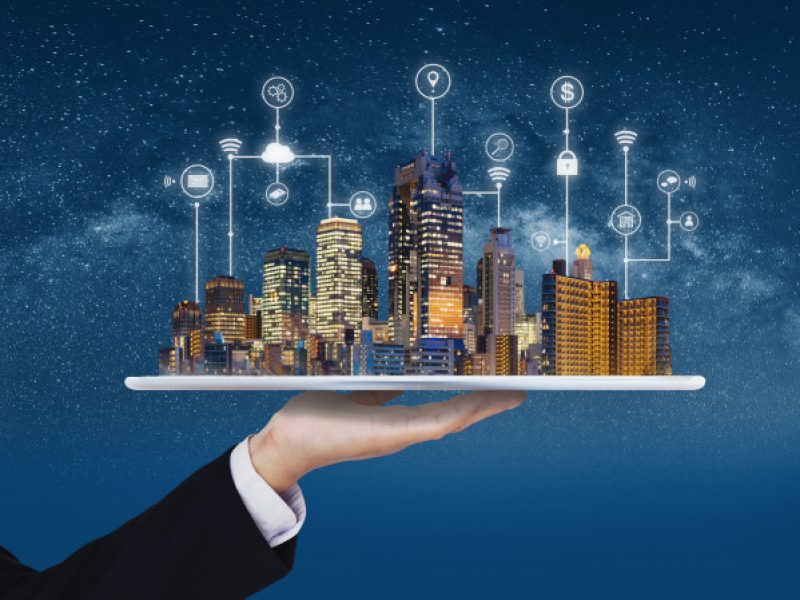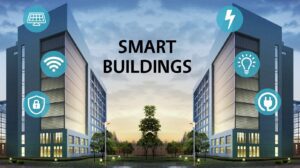

The Marvels of Smart Infrastructure: Building a Smarter Tomorrow
Imagine a world where the buildings you work in know exactly when you need a burst of warmth and when to keep it cool. Roads that chat with your car, guiding it seamlessly through city traffic. Accidents are foretold, like a guardian angel for your commute. Infrastructure is so eco-friendly it’s like giving the planet a much-needed breather. All of this is within our grasp, thanks to the wonders of smart infrastructure. Let’s talk about it in detail, shall we?
This blog will delve into five major aspects where smart infrastructure can ease the lives of citizens.
So, without any further ado, let’s get straight to it.
Here are five major smart infrastructures.
1- Smart Buildings – Your Cozy Haven


Imagine a building that anticipates your every need, adjusting the temperature, lighting, and security in real time. These intelligent structures redefine comfort. Take the thermostat as an example – it’s not just a device but your loyal companion. It knows when you’re home, ensuring warmth in the winter and coolness in the summer, all while conserving energy and reducing your bills. Smart buildings? They’re more like a snug, energy-efficient cocoon.
Smart buildings are designed to make your life easier and more comfortable. The concept revolves around the use of interconnected devices and sensors that collect data from your surroundings. These sensors can detect when you’re in a room, your preferred temperature, and even the lighting conditions you prefer.
For instance, if you like your living room cozy in the evening, your smart building will ensure that the lights dim and the temperature rises as the sun sets. No more fiddling with thermostats and light switches. It’s all taken care of.
But it’s not just about comfort. Smart buildings are eco-friendly too. They can adapt to changing weather conditions, harness natural energy, and even optimize energy consumption. This not only lowers your energy bills but also reduces the carbon footprint of your building.
2- Intelligent Roads – Smooth Sailing Ahead


Now, picture a road that talks to your car. Intelligent roads are like personal guides for your vehicle, keeping you safe and your commute hassle-free. They can relay crucial information about traffic conditions, potential hazards, and even assist in parking. Next time you hit the road, it’s not just you navigating; it’s you and your smart road, your reliable copilot.
Smart roads are embedded with sensors that monitor traffic, weather conditions, and even the road’s integrity. These sensors continuously transmit data to a central system that can instantly alert drivers to potential hazards.
To elaborate it more clearly, if there’s a patch of ice up ahead, your smart road can communicate this to your car, which might adjust the traction control or even notify you to drive cautiously. Smart roads can also ease congestion by coordinating traffic signals to optimize the flow of vehicles. This means less time stuck in traffic and a more efficient commute.
Intelligent roads can also help build next-level parking. They can detect available parking spaces and transmit this information to your car or smartphone, allowing you to quickly locate a nearby parking spot. No more circling the block in search of a parking space. How cool is that, right?
3- Predicting Accidents – Your Guardian Angel of Roads


Ever wish for a guardian angel on the road? Well, smart infrastructure comes pretty close. Thanks to advanced sensors, accidents can be predicted before they occur. Think of it as a warning system that ensures your safety. These sensors detect issues like icy patches or sudden traffic slowdowns, allowing you to steer clear of potential danger. The result? Safer roads and more peace of mind.
Accidents on the road are a serious concern, often leading to injuries, fatalities, and property damage. Predictive accident detection systems are like having a guardian angel watching over you as you drive.
These systems rely on a network of sensors that are installed along highways and major roadways. They continuously monitor road conditions and traffic flow. When they detect a hazardous situation, like a sudden slowdown or the presence of ice, they can issue warnings to drivers through digital signs, flashing lights, or even directly to the dashboard of your car. Like, if there’s a traffic jam up ahead, you might receive a warning to slow down or take an alternative route. If there’s black ice on the road, your car’s anti-lock brake system might be activated to prevent skidding.
4- Eco-Friendly Innovations – Saving the Planet, One Watt at a Time
These innovations are like eco-warriors, curbing energy consumption and reducing emissions. Just imagine the environmental impact when cities collectively reduce their carbon footprint. It’s like a breath of fresh air for Mother Earth, and it’s something we all should support.
The environment is a global concern, and we all need to take steps to reduce our impact on it. Smart infrastructure plays a significant role in reducing energy consumption, conserving natural resources, and cutting down on pollution.
Smart buildings are designed to be eco-friendly from the ground up. They harness natural energy sources like sunlight and wind to generate power. Additionally, they use advanced insulation and design to maintain a comfortable temperature without excessive heating or cooling. They also manage lighting, ensuring it’s only active when and where it’s needed.
Smart roads can contribute to environmental preservation as well. The systems that monitor traffic flow and control traffic signals can significantly reduce congestion. Fewer vehicles idling in traffic jams mean less fuel consumption and lower emissions.
Additionally, many smart cities are incorporating green spaces, bike lanes, and walking paths to encourage more eco-friendly modes of transportation.
Now, last but not least . . .
5- The Power of Connectivity – A Web that Keeps Us Together


The true beauty of smart infrastructure lies in its connectivity. Buildings, roads, and safety systems – they’re all part of a web that keeps our communities together. This web isn’t just about wires; it’s about connecting people. The more we understand, embrace, and participate in these technological marvels, the closer we get to building a smarter, safer, and sustainable future. So, let’s all take a step into this exciting world.
Smart infrastructure operates as a network, with various components communicating with each other. This connectivity is the lifeblood of smart cities and is what makes them truly intelligent.
How does it work? Well, if there’s a traffic jam on a smart road, it can automatically notify your smart building to adjust your heating schedule to account for a longer commute. It can also inform you through a smartphone app about the delay, offering alternate routes and even suggesting you delay your departure.
Moreover, the data collected by various sensors and systems can be analyzed to improve urban planning. This means better traffic management, more efficient public services, and an overall improved quality of life.
As we step into a more connected world, it’s crucial for us to understand these technologies. The more we learn and participate, the better equipped we are to shape a future we’d love to live in.
Conclusion
We live in a global village filled with opportunities and prospects where smart infrastructure stands as a beacon of promise. It’s not just technological advancement. It’s far beyond that. It’s about making our lives better, safer, and more eco-friendly. As we step into the future, let’s not hesitate to embrace these marvels, for they have the potential to shape a world we’d love to live in. The smart future isn’t a distant dream; it’s a reality in the making. It is waiting for you to realize it.


Leave a Reply